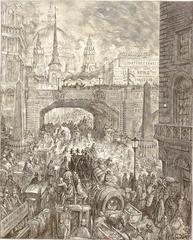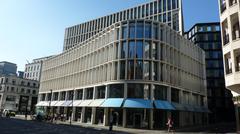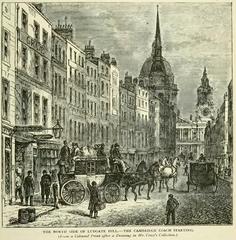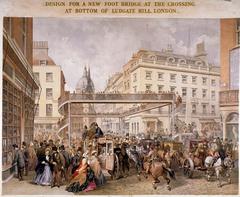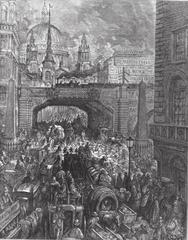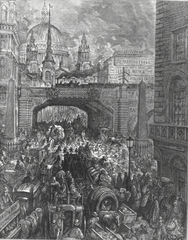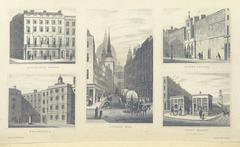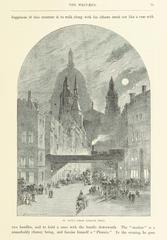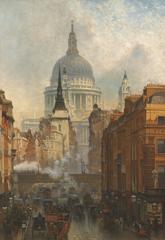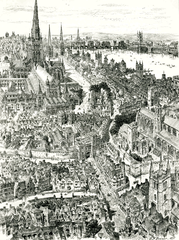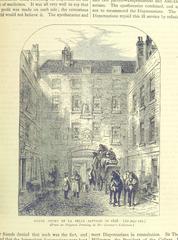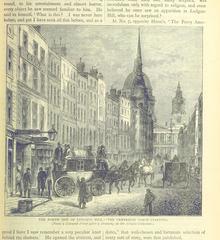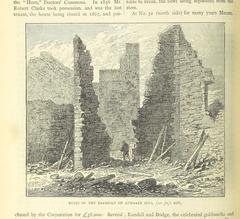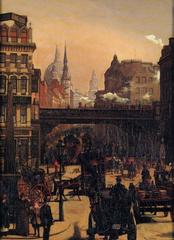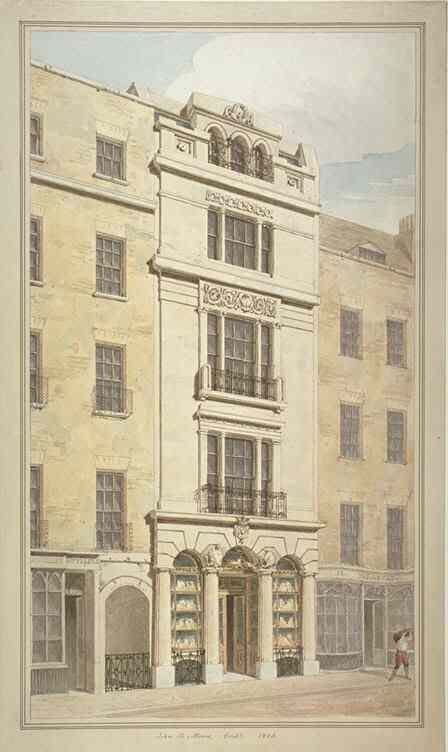
Ludgate Hill Visiting Hours, Tickets, and London Historical Sites Guide
Date: 14/06/2025
Introduction
Ludgate Hill, rising in the heart of the City of London, is a place where ancient history, architectural grandeur, and vibrant city life intersect. As one of London’s three ancient hills—alongside Tower Hill and Cornhill—Ludgate Hill has witnessed the city’s transformation from Roman Londinium to today’s global metropolis. Its name, deriving from the Old English “hlid-geat” meaning “postern” or “swing gate,” reflects its longstanding role as a gateway to the city (Londonist; Memoirs of a Metro Girl). While legends connect it to the mythical King Lud, modern scholarship highlights its historical and archaeological significance.
Today, Ludgate Hill is renowned for hosting St Paul’s Cathedral—Sir Christopher Wren’s architectural masterpiece—while also offering visitors a layered historical experience through its streets, churches, and public art. The area is easily accessible via St Paul’s and Blackfriars Underground stations and is surrounded by a lively blend of historic and contemporary attractions (Following the Rivera; St Paul’s Cathedral Official Site).
This guide provides a comprehensive overview of Ludgate Hill’s history, practical visitor information, ticketing, accessibility, nearby attractions, and tips for making the most of your visit.
Table of Contents
- Ancient Origins and Name
- Roman and Medieval Foundations
- Ludgate Gate: Fortress and Prison
- Demolition and Urban Evolution
- Commercial and Cultural Hub
- St Paul’s Cathedral and Architectural Highlights
- Victorian and Modern Developments
- Visiting Ludgate Hill: Hours, Tickets, and Accessibility
- Travel Tips and Nearby Attractions
- Myths, Memory, and Cultural Legacy
- Frequently Asked Questions (FAQs)
- Summary and Final Tips
- References
Ancient Origins and Name
Ludgate Hill’s name is rooted in Old English, with “hlid-geat” meaning a swinging or postern gate. This etymology points to its function as a key gateway in the Roman London Wall. While medieval chroniclers like Geoffrey of Monmouth attributed its name to the legendary King Lud—purported founder of London—modern historians regard this as myth, with no archaeological evidence supporting a pre-Roman city (Londonist; Local History Videos).
Roman and Medieval Foundations
Archaeological evidence shows the area was significant in Roman times, with sepulchral stones uncovered near St Martin’s Church indicating a Roman cemetery (British History Online). The original Lud Gate, likely built around 200 AD, became a vital western entrance to Londinium. In the medieval period, Ludgate was rebuilt and fortified, especially during the 13th century when it played a role in the city’s defense during the Magna Carta conflict (Memoirs of a Metro Girl).
Ludgate Gate: Fortress and Prison
Over time, Ludgate’s function evolved from a defensive structure to a debtor’s prison in the upper rooms of the gate by the 14th century. The prison was expanded in the 15th century due to the efforts of Dame Agnes Forster, and the gate itself was adorned with statues—most notably of King Lud and Queen Elizabeth I. The gate was rebuilt multiple times, reflecting its ongoing civic importance (British History Online).
Demolition and Urban Evolution
By the mid-18th century, Ludgate and its prison had outlived their utility and were demolished in 1760. This cleared the way for modern development and improved urban flow. While the gate is gone, a plaque on St Martin-within-Ludgate marks its former site, with some original fragments nearby (Memoirs of a Metro Girl; Local History Videos).
Commercial and Cultural Hub
Between the 16th and 19th centuries, Ludgate Hill became a center for commerce and publishing. Renowned inns, goldsmiths, and fashionable shops lined the streets, attracting shoppers and socialites. Historical events, such as the execution of Gunpowder Plot conspirators, further cemented its place in London’s civic life (Local History Videos).
St Paul’s Cathedral and Architectural Highlights
St Paul’s Cathedral dominates Ludgate Hill as London’s most recognizable religious building. Rebuilt by Sir Christopher Wren after the Great Fire of London, the current cathedral was completed in 1711. It has hosted major national events, including royal weddings and state funerals. The nearby St Martin-within-Ludgate church, also designed by Wren, and Victorian bank buildings reflect the area’s layered architectural heritage (London Hut; Memoirs of a Metro Girl).
Victorian and Modern Developments
The 19th and 20th centuries saw rapid modernization. The Ludgate Hill railway station, built in 1865, and later developments brought new infrastructure and commercial spaces. Today, Ludgate Hill connects Fleet Street and St Paul’s, serving as a vibrant artery for business and tourism. The London Stock Exchange’s move to nearby Paternoster Square in 2004 is a testament to the area’s continued economic relevance (Local History Videos).
Visiting Ludgate Hill: Hours, Tickets, and Accessibility
- Ludgate Hill: Open to the public at all times, no entry fee.
- St Paul’s Cathedral: Open Monday–Saturday, 8:30 AM–4:00 PM (last admission 3:30 PM). Closed to tourists on Sundays (St Paul’s Cathedral Official Site). Standard adult tickets are approximately £20, with concessions for students and seniors. Children under 17 often enter free; check the website for current details and to book in advance.
- Accessibility: The area is pedestrian-friendly and accessible via St Paul’s (Central Line) and Blackfriars (Circle/District) Underground stations, as well as City Thameslink. St Paul’s Cathedral offers step-free access, though dome climbs involve stairs.
Travel Tips and Nearby Attractions
- Best Times to Visit: Early mornings or late afternoons are quieter. June offers pleasant weather and extended daylight.
- Nearby Attractions: Explore Fleet Street, the Museum of London, Paternoster Square, and the Millennium Bridge to Tate Modern.
- Amenities: Numerous cafes and restaurants are found on and around Ludgate Hill.
- Guided Tours: Walking tours and audio guides are available; check online or via the Audiala app for options.
- Events: Ludgate Hill is a hub during city festivals and the London Festival of Architecture, featuring public art installations (FLO London).
Myths, Memory, and Cultural Legacy
Though the original gate is lost, the legend of King Lud endures through sculptures and plaques around Ludgate Circus and Fleet Street (Londonist; Mysterious Britain & Ireland). Ludgate Hill’s enduring appeal lies in its rich blend of myth, history, and ongoing urban life.
Frequently Asked Questions (FAQs)
Q: Is there an entry fee for Ludgate Hill?
A: The street is free to visit. St Paul’s Cathedral charges for sightseeing visits.
Q: What are the visiting hours for St Paul’s Cathedral?
A: Monday–Saturday, 8:30 AM–4:00 PM. Closed to tourists on Sundays (St Paul’s Cathedral Official Site).
Q: Is Ludgate Hill accessible for those with disabilities?
A: Yes. The streets are largely accessible, and St Paul’s Cathedral provides step-free access, except for the dome climb.
Q: Are guided tours available?
A: Yes. Walking tours and audio guides include Ludgate Hill and St Paul’s Cathedral.
Q: How do I get to Ludgate Hill?
A: The nearest Underground stations are St Paul’s and Blackfriars. City Thameslink is nearby, and many bus routes serve the area.
Summary and Final Tips
Ludgate Hill is a microcosm of London’s layered past and dynamic present. From Roman origins and medieval legends to the awe-inspiring St Paul’s Cathedral and vibrant modern city life, it offers visitors a journey through centuries of history. Enjoy easy access, a wealth of attractions, and a lively urban setting—whether you’re exploring on foot, joining a tour, or attending a major event.
For the best experience, plan ahead by checking St Paul’s Cathedral’s hours and ticket policies, use public transport, and take advantage of guided or virtual tours to deepen your understanding. Don’t forget to explore nearby landmarks and savor the local atmosphere in cafes and squares.
Download the Audiala app for updated guides, maps, and exclusive content. Follow us on social media for the latest on London’s historic sites and cultural events.
References
- Memoirs of a Metro Girl
- Mysterious Britain & Ireland
- Following the Rivera
- FLO London
- Londonist
- St Paul’s Cathedral Official Site

